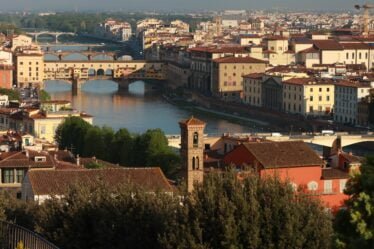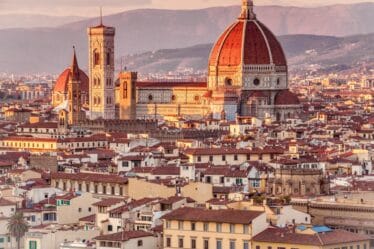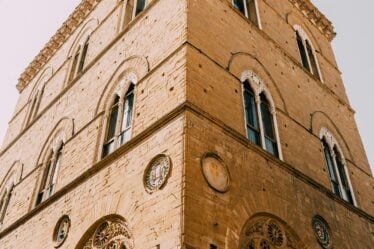

The Baptistery of Florence, known as the Baptistery of San Giovanni (Battistero di San Giovanni), is one of the oldest buildings in the city and a significant symbol of its rich history and artistic heritage. It is located in the Piazza del Duomo, just in front of the Florence Cathedral (Santa Maria del Fiore) and the Giotto’s Campanile.
- Early Origins: The origins of the Baptistery trace back to the Roman period when Florence was known as Florentia. The site of the Baptistery was likely a Roman religious structure, possibly a temple dedicated to Mars, the Roman god of war. With the spread of Christianity in the region, the temple was repurposed into a Christian baptistery.
- Christianization: By the early Middle Ages, baptisteries became essential structures in Christian communities for administering the sacrament of baptism. The Baptistery of Florence served as the principal baptistery for the city, where individuals underwent the ritual of baptism, marking their entry into the Christian faith.
- Construction and Expansion: The current structure of the Baptistery dates primarily to the 11th and 12th centuries, although it underwent significant renovations and expansions over the centuries. The exterior features the characteristic octagonal shape, while the interior showcases Byzantine-inspired mosaics and decorative elements.
- Artistic Development: One of the most significant periods in the history of the Baptistery was during the Renaissance when renowned artists contributed to its embellishment. Notably, the competition held in 1401 for the commission of the Baptistery’s bronze doors led to the creation of the celebrated Gates of Paradise by Lorenzo Ghiberti.
- Religious and Civic Functions: In addition to its religious significance as a baptistery, the building also served various civic and ceremonial purposes throughout its history. It hosted important events such as the annual singing competition for the Mass setting known as the “Sposalizio del Mare” (Marriage of the Sea).
- Symbolism and Identity: The Baptistery became an enduring symbol of Florence’s identity and cultural legacy. Its prominent location in the heart of the city, adjacent to the Florence Cathedral and the Giotto’s Campanile, underscores its significance as a focal point of religious and artistic expression.
- Restorations and Preservation: Over the centuries, the Baptistery has undergone numerous renovations and preservation efforts to safeguard its architectural integrity and artistic treasures. These endeavors continue to ensure that the Baptistery remains accessible for future generations to appreciate and admire.
- Modern Significance: Today, the Baptistery of Florence remains a cherished cultural landmark and a UNESCO World Heritage Site. It continues to attract visitors from around the world who come to marvel at its architectural splendor, intricate artwork, and profound historical significance.
The Baptistery’s rich history reflects the evolution of Florence itself, from its Roman origins through the medieval and Renaissance periods to its status as a global center of art, culture, and history. If you want discover more about the city of Florence you can come to our Free Tour of Florence, we are running a free walking tour of Florence form Santa Maria Novella square. Our meeting point is in front of Minerva Hotel .



